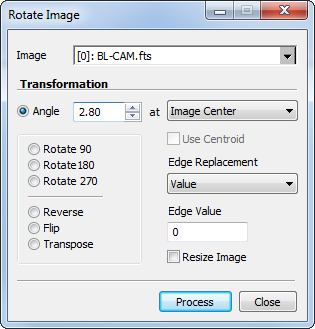
Rotate Image
The Rotate Image command can rotate an image or image set in 90 degree steps, perform mirror flips, transpose about the main diagonal, and apply free rotation using any precise angle. You also can rotate an image by an angle using the button on the Image Toolbar.
This command opens from the Process > Geometry pull-down menu.

|
Angle |
The rotation angle, measured in degrees. |
|
at |
When Angle is selected, this parameter specifies the center of rotation. You can shooise either the center of the image or the centroid coordinate near the center of the image cursor (see section below) |
|
Rotate 90 |
Check this box to rotate 90 degrees in the positive sense. |
|
Rotate 180 |
Check this box to rotate 180 degrees. |
|
Rotate 270 |
Check this box to rotate 270 degrees in the positive sense. |
|
Reverse |
Check this box to mirror flip the image in a left/right sense. |
|
Flip |
Check this box to mirror flip the image in an up/down sense. |
|
Transpose |
Check this box to flip the image about its main diagonal, which extends from pixel [1,1] to the opposite corner. |
|
Use Centroid |
If selecting the Image Cursor option, check this box to have the center of rotation at a centroid position near the center of the cursor. For example, you may want the image rotated about the center of a star. |
|
Edge Replacement |
Defines the method used to evaluate "blank" pixels when the rotation brings non-existing data into the output image. The options Value and Image Margin are described in the section below. |
|
Edge Value |
The value to assign values to the edge pixels when Edge Replacement = Value. |
|
Resize Image |
Check this box to allow the image to be enlarged to hold all pixels after rotation. If this box is not checked, the image size remains the same and the corner pixels rotate outside the visible image. |
The image is rotated about a point that can be selected from the following options:
Center: Rotates the image about the center position.
Cursor: Rotates the image using the center of the Image Cursor.
There are two ways to do a Cursor Rotation:
Centroid checked: Rotates about the centroid coordinate near the center of the Image Cursor.
Centroid unchecked: Rotates about the center of the Image Cursor.
If using the image cursor be sure to position it before opening the menu containing this command.
The "edge" refers to the blank pixels that rotate into the output image from off the edge of the original image. These pixels have no value but some values must be assigned to them in the rotated image. Examples.
Mira givew you 2 options for assigning a value to the edge pixels:
Image Margin: Mira computes a value typical of pixels around the margin of the image.
Value: Mira uses the pixel value you specify in the Edge Value field. This can be a luminance value or a color value. For example, 0 and 500.25 are luminance values, and 255,128,0 is a color value.
The Transpose operation reflects pixels across the main diagonal of the image matrix. FITS image have their main diagonal running from the lower left toward the upper right. Other graphics formats have their main diagonal running from upper left to lower right.
Geometry Commands, Register Images, Rotate Angle